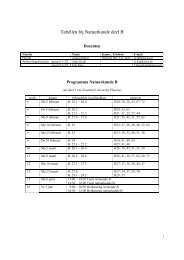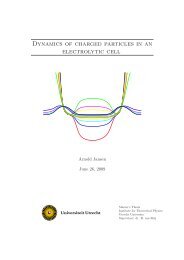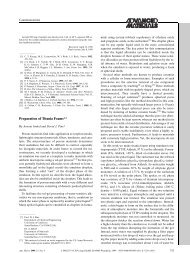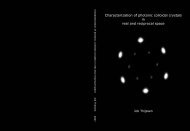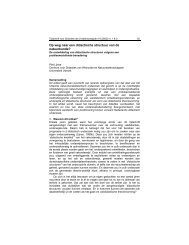species, and (B) L i = 2 × (250/Z i ) 3/2 mm. Case B mimics the situation forspheres <strong>of</strong> different size but the same mass density and surface charge density,such that Z i is proportional to the surface area and L i to the inverse volume<strong>of</strong> species i, i.e. L 2 i Zi3 is a constant independent if i. The density pr<strong>of</strong>iles,numerically obtained by solving the Eqs.(A.3) and (A.4) for H = 20cm,λ B = 2.3nm, ρ s = 3µM, and ¯η tot = ∑ 21i=1 ¯η i = 0.005, are shown in Fig.3 forall 21 components. Case A shows pr<strong>of</strong>ound lifting and layering, where theordering is again determined by mass-per-charge as illustrated by the threedashed curves (for Z i = 250, 279, and 299) showing that the colloids in thehigh-charge wing <strong>of</strong> the distribution reside at high altitudes. Fig.3(b) showsthe density pr<strong>of</strong>iles for case B, which does exhibit lifting, but hardly anylayering, and no density inversion at all. This is completely consistent withthe picture that the ordering is determined by Z i L i , which for case B is suchthat Z i L i /Z j L j = √ Z j /Z i , i.e. the highly-charged particle are expected atthe bottom while the relative spread in Z i L i is relatively small compared tocase A, where Z i L i /Z j L j = Z i /Z j . The inset <strong>of</strong> (b) shows the total packingfraction pr<strong>of</strong>iles η tot (x) = ∑ 21i=1 η i(x) <strong>of</strong> both case A and B together with theone-component pr<strong>of</strong>ile (n = 1) with Z 1 = 250 and L 1 = 2mm at ¯η 1 = 0.005.Perhaps surprisingly there is hardly any distinction between the pure systemand case B, whereas there is a small difference with case A. These pr<strong>of</strong>ilesshow that the main distinction between these polydisperse systems and theunderlying one-component one concerns the layering phenomenon (providedZ i L i varies sufficiently for all the species), and not the total distribution <strong>of</strong> thecolloids. Perhaps this fractionation effect could be exploited experimentallyto purify a polydisperse mixture.A.6 Conclusions and discussionWe have studied sedimentation equilibrium <strong>of</strong> n-component systems <strong>of</strong> chargedcolloidal particles at low salinity by minimising a Poisson-Boltzmann-likedensity functional w.r.t. density pr<strong>of</strong>iles on a one dimensional grid <strong>of</strong> heights.For n = 1 the theory reduces to the one-component studies as presented inRef.[8, 14], and for n = 2 we quantitatively reproduce the simulation results<strong>of</strong> Ref.[15], where density inversion was found. These effects are caused by aself-consistent electric field that lifts the higher charged (heavy) particles tohigher altitudes than the lower charged (lighter) colloids. We show that thelayering <strong>of</strong> the colloids according to mass-per-charge can persist for ternary(n = 3) as well as for polydisperse (here n = 21) mixtures. Given the goodaccount that the present theory gives for simulations [14] and experiments[11, 12, 13] <strong>of</strong> one-component systems, and for the simulations <strong>of</strong> binary60
Z 16 =29932a10 3 η iZ 11 =2500.60.40.20150 200 250 300 350Z i10 3 η i0 5 10 15 201.5bA1010 3 η totB51010 3 0 5 10 15 20η i X (cm)151Z 14 =2790.500 5 10 15 20X (cm)00 5 10 15 20X (cm)Figure A.3: Density pr<strong>of</strong>iles <strong>of</strong> a 21-component colloidal suspension with aGaussian charge distribution as illustrated in the inset <strong>of</strong> (a), at total packingfraction 0.005, reservoir salt concentration ρ s = 3µM, and Bjerrum lengthλ B = 2.3nm. The gravitational lengths are as in case A (see main text) in(a), and case B in (b). In (b) the solid curves are for Z i > 250, and thedashed ones for Z i ≤ 250. The inset <strong>of</strong> (b) shows the total packing fractionpr<strong>of</strong>ile for case A and B, together with that <strong>of</strong> the underlying one-componentsystem (see main text).systems [15], it is tempting to argue that the theory is also (qualitatively)reliable for ternary or polydisperse systems, i.e. the predicted segregationand layering should be experimentally observable. One should bare in mind,however, that the present theory ignores the hard-core <strong>of</strong> the colloidal particles,and is therefore expected to break down at higher packing fractions(say η > 0.1) . It also ignores effects due to charge renormalisation, whichbecomes relevant when Z i λ B /σ i ≫ 1. Work on extending the theory in thesedirections is in progress [18, 17].All results presented in this paper were obtained with the zero-field boundaryconditions φ ′ (0) = φ ′ (H) = 0. We checked explicitly, however, thatother boundary conditions that respect global charge neutrality, such asφ ′ (0) = φ ′ (H) = eE ext /k B T (describing a suspension in a homogeneous externalelectric field E ext ) or φ(0) = φ(H) and φ ′ (0) = φ ′ (H) (describing ashort-circuited bottom and meniscus) give indistinguishable density pr<strong>of</strong>iles,except in two layers <strong>of</strong> thickness ∼ κ −1 ≪ 10µm in the vicinity <strong>of</strong> the bottomand the meniscus. This insensitivity to the boundary conditions is not surprising:the whole phenomenology in these systems is driven by the entropy<strong>of</strong> the microscopic ions, i.e. a bulk contribution to the grand potential thatshould dominate any boundary (surface) contribution.61




